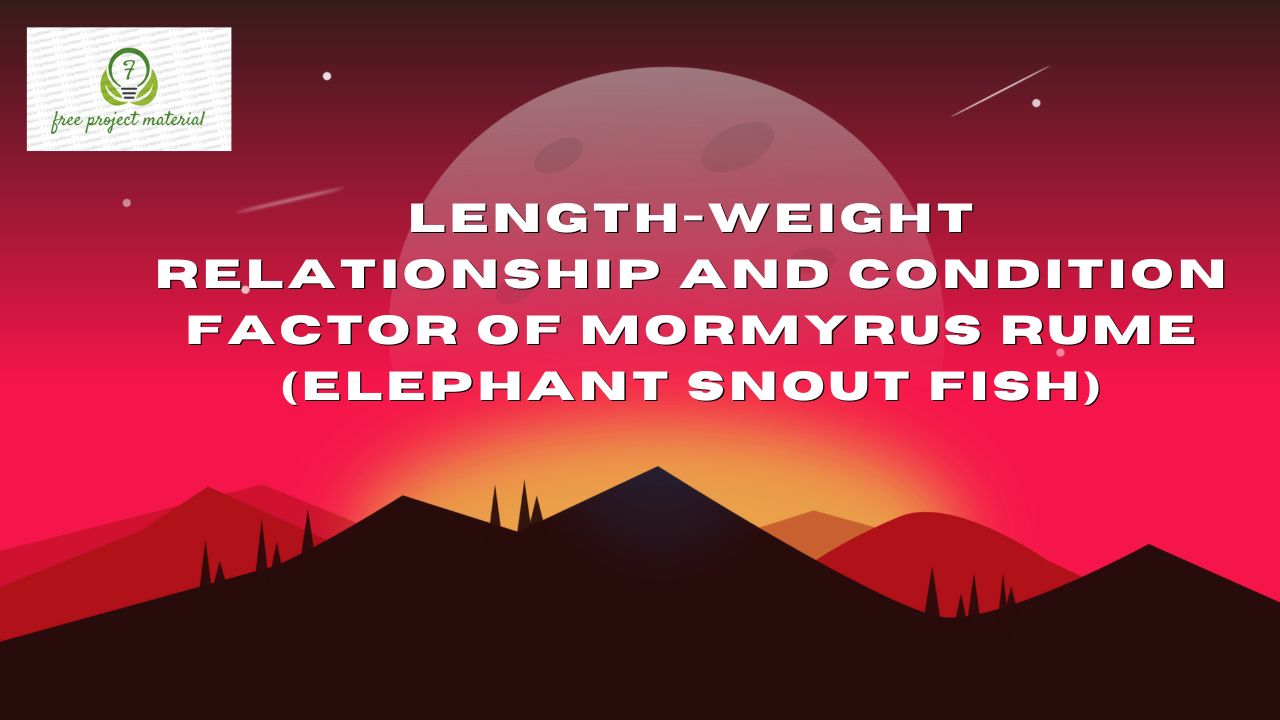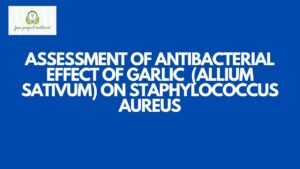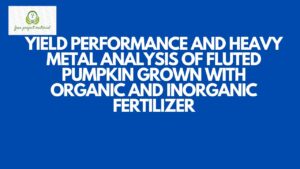ABSTRACTS
The length-weight relationship and condition factor Mormyrus rume from Itak Nyanyangha landing site along Cross River, Itu Akwa Ibom State, was conducted on the month of (September 2019). A total of thirty eight (38) fish samples were bought. The length-weight relationship and condition factor (K) were determined using the equation W= alb and K = Wx 100/Lb respectively. The highest weight recorded was 278.86 while the least was 11.44g. in terms of lengths, smallest fish was 19cm and the longest fish was 22.4. in conclusion, Mormyrus rume exhibited positive allometric growth pattern . The fish becomes relatively stouter as it increases in length. condition factor were greater than 1 which implied that they are in a good physiological condition.
LIST OF TABLES
TABLE 4.1: length weight relationship and condition factor – 21-24
LIST OF FIGURES
FIGURE 2.1 : Diagram of Mormyrus rume – – – 9
TABLE OF CONTENTS
PAGES
TITLE PAGE – – – – – – – – i
CERTIFICATIONS – – – – – – – ii
DEDICATIONS – – – – – – – – iii
ACKNOWLEDGEMENTS – – – – – – iv-v
ABSTRACTS – – – – – – – – vi
LIST OF TABLES – – – – – – – vii
LIST OF FIGURES – – – – – – – viii
TABLE OF CONTENTS – – – – – – ix-xi
CHAPTER ONE
INTRODUCTION
1.1 Background of the Study – – – – – – 1-3
1.2 Aim and Objectives of the Study – – – – 3
1.3 Scope and Limitation of the Study – – – – 4
1.4 Definition of Terms – – – – – – 4-5
CHAPTER TWO
2.0 LITERATURE REVIEW – – – – – 6-8
2.1 Classification of Mormyrus rume – – – – 8-9
2.2 The concept of Length-Weight Relationship – – 10-12
2.3 The Condition Factor in Length-Weight Relationship – 12-13
2.4 Standard Weight of Fish – – – – – 13-15
2.5 Factors Affecting Standard weight of Fish – – – 15-16
2.6 Application of Standard Weight of Fish – – – 16-17
CHAPTER THREE
3.0 MATERIALS AND METHOD – – – – 18
3.1 Materials – – – – – – – 18
3.2 Methods – – – – – – – – 18
3.2.1 The Study Area – – – – – – – – 18
3.2.2 Collection of Fish – – – – – – – 19-20
3.2.3 Data Collection and Analysis – – – – – 20
CHAPTER FOUR
4.0 RESULT AND DISCUSSION
4.1 Result – – – – – – – – 21-24
4.2 Discussion – – – – – – – – 25-27
CHAPTER FIVE
5.0 CONCLUSION AND RECOMMENDATION
5.1 Conclusion – – – – – – – – 28
5.2 Recommendation – – – – – – – 29
References
CHAPTER ONE
INTRODUCTION
1.1 Background of the Study
The relationship between length and weights is of importance in fishery biology, ecology fisheries management and their stock assessments. The importance of length weight relationship and condition factor in fisheries biology cannot be overstated as useful for estimating the weight of a fish of a given length. These carnivorous species are good quality food fish of white and very tasty fish serving as delicacy for many low income earners (Reed et al., 1997) especially in riverine communities. In addition they are important both in ecological and environmental terms, playing salient role in determining the dynamics and structure if aquatic ecosystem (Coulter, 1992). According to Akinsanya et al., (2007), the emanating need to culture fishes for protein consumption for the teamingly rapidly growing populations in the developing countries have made it necessary to study the length-weight relationship (LWR) of these species in order to provide an increase the knowledge of the stock available.
The LWR is one of the standard methods that yield valid biological information. It established the mathematical relationship between the two variables, length and weight so that unknown variable can be readily computed form the known variables. Also it shows the variation from the expected weight from the known length groups, this is in turn reflect it factors, general wellbeing, good development and suitability of environment of the fish (Le Cren, 1991). The condition factor (CF) is an index reflecting the interactions between biotic and abiotic factor in the physiological conditions of fishes. It shows the welfare of the population during the various stages of life cycle (Angelescu et al., 1998).
The importance of length-weight relationship and condition factor of fishes has inspired a large number of works in South Western Nigeria lakes and reservoir (Ayandiran et al., 2004). Therefore the present study was undertaken to elucidate the pattern of growth and general well-being of these fish species in this reservoir. Organism generally increase in size (length-weight) during development. The key factors that influence the growth of fish are the quantity of food available, the number of fish utilizing sme food source, temperature, oxygen, water quantity size, age and sexual maturity of the fish. Since length weight relationship and condition factors is a perfect indicator to assess the welfare of fish.
1.2 Aim and Objectives of the Study
This work is aimed t determine the length-weight relationship and condition factors of Mormurus rume the specific objectives of the study are; to determine the length-weight relationship of Mormurus rume
To determine the condition factor of Mormurus rume
To determine the weight of Mormurus rume with the standard weight of fish
To suggest useful recommendation based on the findings.
1.3 Scope and Limitations of the Study
This study only covers the determinations of the length-weight relationship and condition factors of Mormurus rume.
- The limitations encountered in the course of this work are
- Financial constraint
- Poor Power supply
- Time Constraint
- Limited Literature materials to assist in adequate project research.
1.4 Definition of Terms
Estimation: A rough calculation of the value number quantity or extent of something.
Length: this is the longer or longest dimension of an object.
Weight: this is the relative mass or the quantity of matter contained by it.
Relationship: the condition of being related or association.
Condition Factor: this is external appearance and salinity transfer of salmonids.
Habitat: this is a place where an organism lives both living and non-living things.
Fish: this is a limbless cold-blooded vertebrate animal with gills and fins living wholly in water.
Aquatic: an aquatic is an animal, either vertebrate or invertebrate which lives in the water for all tits lifetime.



